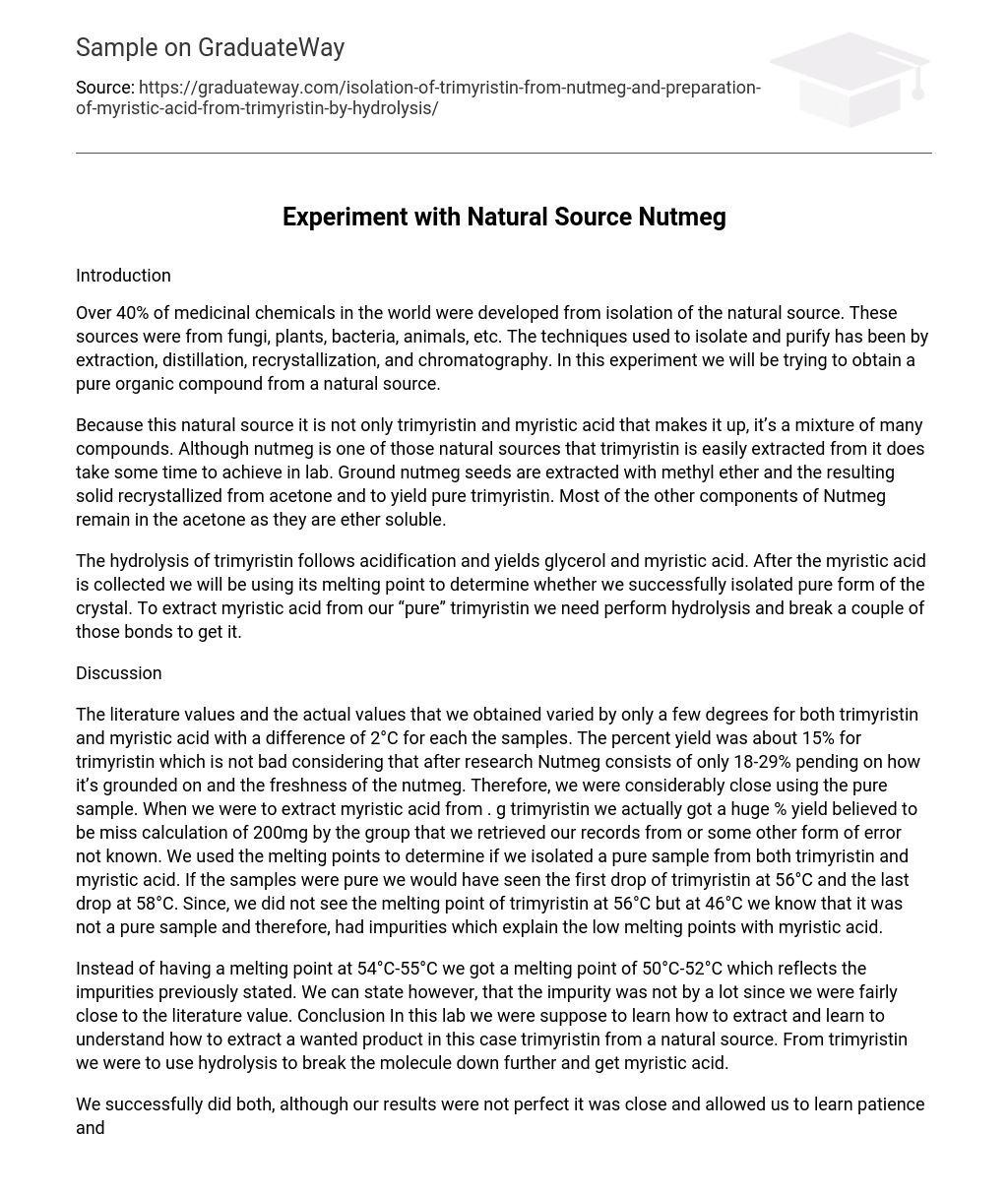Introduction
Over 40% of medicinal chemicals in the world were developed from isolation of the natural source. These sources were from fungi, plants, bacteria, animals, etc. The techniques used to isolate and purify has been by extraction, distillation, recrystallization, and chromatography. In this experiment we will be trying to obtain a pure organic compound from a natural source.
Because this natural source it is not only trimyristin and myristic acid that makes it up, it’s a mixture of many compounds. Although nutmeg is one of those natural sources that trimyristin is easily extracted from it does take some time to achieve in lab. Ground nutmeg seeds are extracted with methyl ether and the resulting solid recrystallized from acetone and to yield pure trimyristin. Most of the other components of Nutmeg remain in the acetone as they are ether soluble.
The hydrolysis of trimyristin follows acidification and yields glycerol and myristic acid. After the myristic acid is collected we will be using its melting point to determine whether we successfully isolated pure form of the crystal. To extract myristic acid from our “pure” trimyristin we need perform hydrolysis and break a couple of those bonds to get it.
Discussion
The literature values and the actual values that we obtained varied by only a few degrees for both trimyristin and myristic acid with a difference of 2°C for each the samples. The percent yield was about 15% for trimyristin which is not bad considering that after research Nutmeg consists of only 18-29% pending on how it’s grounded on and the freshness of the nutmeg. Therefore, we were considerably close using the pure sample. When we were to extract myristic acid from . g trimyristin we actually got a huge % yield believed to be miss calculation of 200mg by the group that we retrieved our records from or some other form of error not known. We used the melting points to determine if we isolated a pure sample from both trimyristin and myristic acid. If the samples were pure we would have seen the first drop of trimyristin at 56°C and the last drop at 58°C. Since, we did not see the melting point of trimyristin at 56°C but at 46°C we know that it was not a pure sample and therefore, had impurities which explain the low melting points with myristic acid.
Instead of having a melting point at 54°C-55°C we got a melting point of 50°C-52°C which reflects the impurities previously stated. We can state however, that the impurity was not by a lot since we were fairly close to the literature value. Conclusion In this lab we were suppose to learn how to extract and learn to understand how to extract a wanted product in this case trimyristin from a natural source. From trimyristin we were to use hydrolysis to break the molecule down further and get myristic acid.
We successfully did both, although our results were not perfect it was close and allowed us to learn patience and to carry out the procedure. This procedure also used to extract coconut oil (which is also a component of trimyristin), palm kernel oil, etc. It’s also used as research component in with many companies because it’s so easily accessible and is easy to extract certain qualities from it. This lab set out to do exactly what it was supposed to by taking us step by step into extracting something from a natural source.
References
- Kilway, K. & Marquez, G. (2006). Solid-Liquid Extraction:Trimyristin from Nutmeg. Retrieved October 10, 2012, from UMKC website: http://d. web. umkc. edu/drewa/Chem321L/Handouts/Lab5Extraction3TrimyristinFromNutmegFS2010. pdf
- [Chem description]. (2012). Retrieved October 10, 2012, from Chem Spider website: http://www. chemspider. com/ Trimyristin, myristic acid, 4-chloroanline, etc. molecular structures, melting points, and molecular weight Experimental Organic Chemistry 2012, laboratory manual: CHM 2210L and CHM 2211L, University of South Florida.





